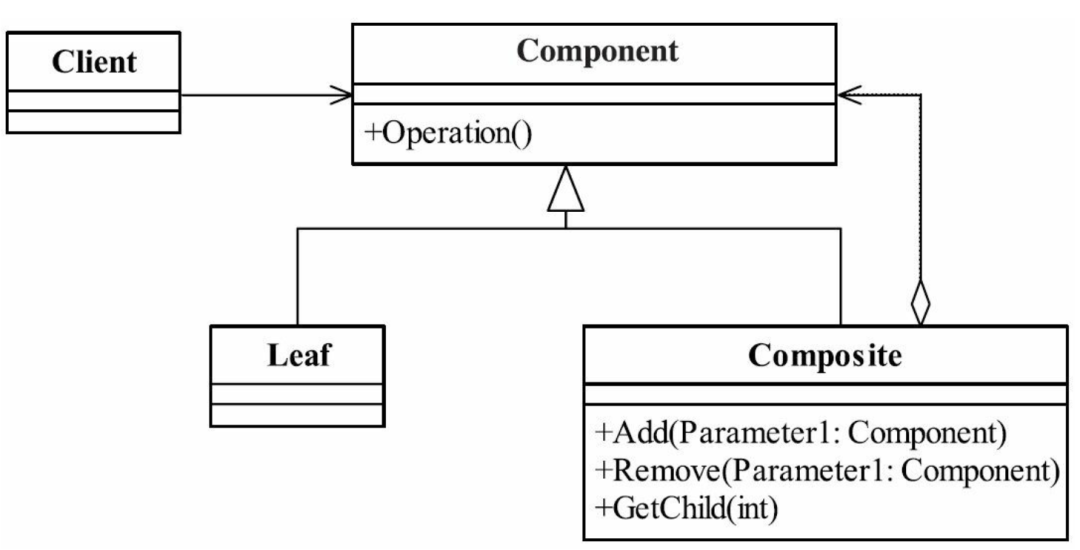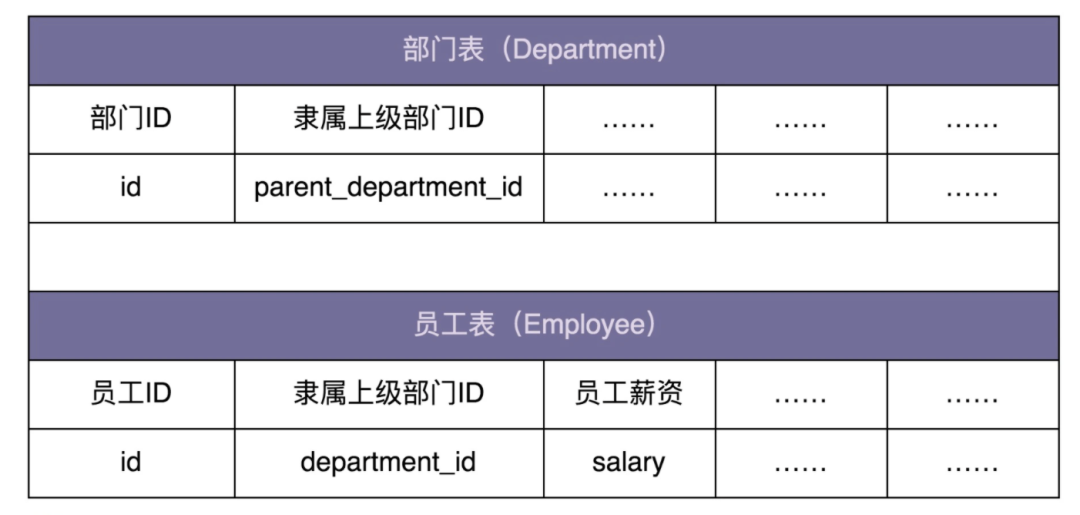

组合模式应该怎么用
描述
相信树形结构大家都知道,但是是否知道用到了什么设计模式吗?
1、什么是组合模式?
Compose objects into tree structures to represent part-whole hierarchies.Composite lets clients treat individual objects and compositions of objects uniformly.
组合模式(Composite Pattern):将对象组合成树形结构以表示“部分-整体”的层次结构, 使得用户对单个对象和组合对象的使用具有一致性。
说人话:用于处理树形结构数据。
2、组合模式定义

①、Component 抽象构件角色
定义参加组合对象的共有方法和属性,可以定义一些默认的行为或属性。
②、Leaf 叶子节点
叶子对象,其下再也没有其他的子节点,是遍历的最小单位。
③、Composite 树枝构件
树枝对象,作用是组合树枝节点和叶子节点形成一个树形结构。
3、组合模式通用代码实现
/**
* 个体和整体的抽象
*/
public abstract class Component {
// 个体和整体都有的共享
public void doSomething(){
// 通用业务逻辑
System.out.println("通用业务逻辑");
}
}
/**
* 树枝节点
*/
public class Composite extends Component{
// 构件容器
private ArrayList< Component > componentArrayList = new ArrayList< >();
// 增加一个叶子节点或者树枝节点
public void add(Component component){
this.componentArrayList.add(component);
}
// 删除一个叶子节点或者树枝节点
public void remove(Component component){
this.componentArrayList.remove(component);
}
// 获取分支下所有叶子节点和树枝节点
public List< Component > getChildren(){
return this.componentArrayList;
}
}
/**
* 叶子节点
*/
public class Leaf extends Component {
// 覆写父类方法
@Override
public void doSomething() {
// 叶子节点逻辑
System.out.println("叶子节点逻辑");
}
}
测试:
public class ClientTest {
public static void main(String[] args) {
// 创建一个根节点
Composite root = new Composite();
root.doSomething();
// 创建一个树枝构件
Composite branch = new Composite();
// 创建一个叶子节点
Leaf leaf = new Leaf();
// 串联起来
root.add(branch);
branch.add(leaf);
display(root);
}
// 通过递归遍历数
public static void display(Composite root){
for(Component c : root.getChildren()){
if(c instanceof Leaf){ // 叶子节点
c.doSomething();
}else{
display((Composite) c);
}
}
}
}
这里我们在举一个例子:
假设我们在开发一个 OA 系统(办公自动化系统)。公司的组织结构包含部门和员工两种数据类型。其中,部门又可以包含子部门和员工。
我们希望在内存中构建整个公司的人员架构图(部门、子部门、员工的隶属关系),并且提供接口计算出部门的薪资成本(隶属于这个部门的所有员工的薪资和)。

/**
* 部门类和员工类的抽象类
*/
public abstract class HumanResource {
protected long id;
protected double salary;
public HumanResource(long id){
this.id = id;
}
public long getId(){
return id;
}
public abstract double calculateSalary();
}
public class Department extends HumanResource{
private List< HumanResource > subNodes = new ArrayList< >();
public Department(long id){
super(id);
}
@Override
public double calculateSalary() {
double totalSalary = 0d;
for (HumanResource hr : subNodes){
totalSalary += hr.calculateSalary();
}
this.salary = totalSalary;
return totalSalary;
}
public void addSubNode(HumanResource humanResource){
subNodes.add(humanResource);
}
}
public class Employee extends HumanResource{
public Employee(long id,double salary){
super(id);
this.salary = salary;
}
@Override
public double calculateSalary() {
return salary;
}
}
测试:
public class PersonClientTest {
private static final long ORGANIZATION_ROOT_ID = 1;
public static void main(String[] args) {
// 创建总部门
Department root = new Department(ORGANIZATION_ROOT_ID);
// 创建子部门
Department branch = new Department(2L);
// 创建员工
Employee employee1 = new Employee(21L,2000);
Employee employee2 = new Employee(22L,4000);
root.addSubNode(branch);
branch.addSubNode(employee1);
branch.addSubNode(employee2);
double v = root.calculateSalary();
System.out.println(v);
}
private void buildOrganization(Department department){
// 根据 部门id 查询数据库 所有下属部门 id
// List< Long > subDepartmentIds = departmentRepo.getSubDepartmentIds(department.getId());
List< Long > subDepartmentIds = new ArrayList< >();
for (Long subDepartmentId : subDepartmentIds){
Department subDepartment = new Department(subDepartmentId);
department.addSubNode(subDepartment);
buildOrganization(subDepartment);
}
// 根据部门id 查询数据库 其关联员工所有 id
// List< Long > employeeIds = employeeRepo.getDepartmentEmployeeIds(department.getId());
List< Long > employeeIds = new ArrayList< >();
for (Long employeeId : employeeIds){
// 根据 employeeId 查询数据库得到 salary
// 假设为 1000
double salary = 1000d;
department.addSubNode(new Employee(employeeId,salary));
}
}
}
4、组合模式优点
①、高层模块调用简单
一棵树形机构中的所有节点都是Component, 局部和整体对调用者来说没有任何区别,也就是说, 高层模块不必关心自己处理的是单个对象还是整个组合结构, 简化了高层模块的代码。
②、节点自由增加
使用了组合模式后, 如果想增加一个树枝节点、 叶子节点都很容易, 只要找到它的父节点就成, 非常容易扩展, 符合开闭原则, 对以后的维护非常有利。
5、组合模式应用场景
只要是树形结构,就可以考虑使用组合模式。
①、维护和展示部分-整体关系的场景, 如树形菜单、 文件和文件夹管理。
②、从一个整体中能够独立出部分模块或功能的场景
-
[5.1.1]--5.1组合模式_clip001jf_75936199 2023-03-10
-
[5.1.1]--5.1组合模式_clip002jf_75936199 2023-03-10
-
匹配模式拆分组合字符串2019-12-11 0
-
用AD转换ADC1的两个通道应该设置成什么模式?2020-05-27 0
-
请问CH375只用直通电源模式应该怎么接?2022-06-27 0
-
在FPGA中何时用组合逻辑或时序逻辑2023-03-06 0
-
用多重分形研究元素的共生组合性2009-03-02 453
-
迷你组合音响的音场模式2010-01-04 1082
-
基于分层组合模式的句子组合模型2017-12-01 494
-
手机上的后置多摄组合有什么用?购机时应该怎么选择?2020-09-07 4436
-
STM32单片机的八种IO口模式,你应该了解下2021-11-26 774
-
组合模式(Composite Pattern)的用法2023-06-01 706
-
设计模式结构性:组合模式2023-06-08 1245
-
设计模式结构性:桥接模式2023-06-08 818
-
多模式 PFC + 电流模式 LLC 组合控制器2024-06-04 7885
全部0条评论

快来发表一下你的评论吧 !

